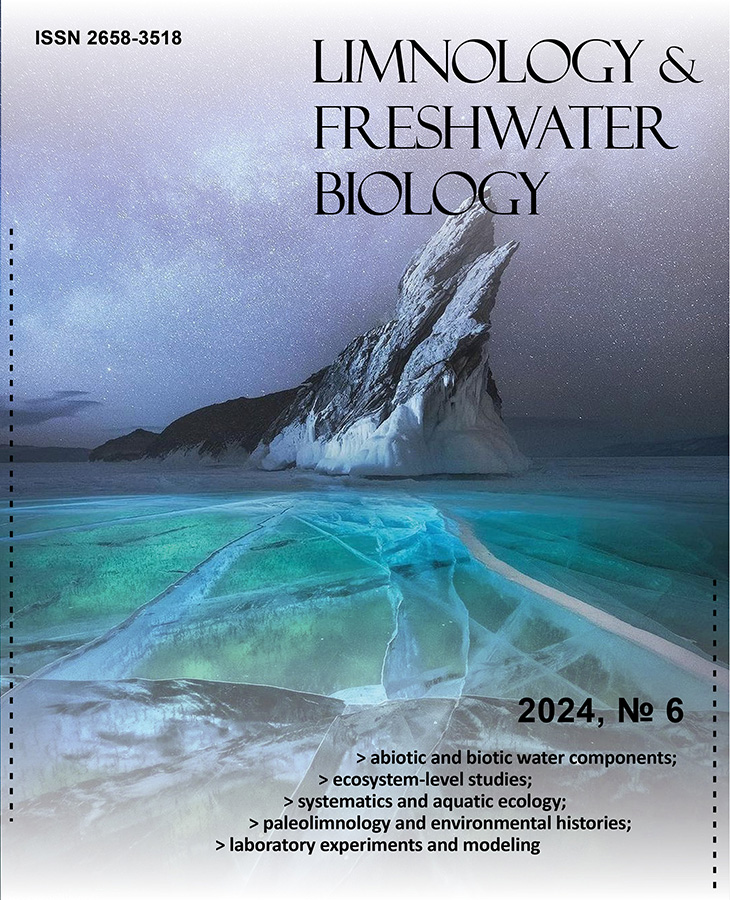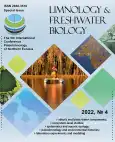Preliminary results of diatom analysis of bottom sediments from Lake Maloe Miassovo (Cheluabinsk Region, Russia)
- Авторы: Valieva E.A.1, Nigamatzyanova G.R.1, Nurgaliev D.K.1, Frolova L.A.1
-
Учреждения:
- Kazan (Volga Region) Federal University
- Выпуск: № 4 (2022)
- Страницы: 1601-1603
- Раздел: Статьи
- URL: https://journal-vniispk.ru/2658-3518/article/view/288340
- DOI: https://doi.org/10.31951/2658-3518-2022-A-4-1601
- ID: 288340
Цитировать
Полный текст
Аннотация
In this study the diatom results of analysis a 510 cm long continuous sediments core from Lake Maloe Miassovo (South Urals, Russia) are presented. The core was collected in July 2018 from central part of the lake from a depth of 7 m. Diatom analysis of samples revealed 38 taxa, belonging to 29 genera and 18 family. The analysis of the ecological structure of the diatom flora of the sediment core sample from the lake under study shows that it is dominated by the Holarctic representatives of benthic and fouling organisms giving preference to the alkaline environmental conditions, which is due to the shallowness of the lake. The prevalence of Staurosira construens Ehrenberg diatom in sediments have been established. Diatom diagram has been divided into two diatom zones on the basis on changing diatom abundances and taxa composition Diatoms were found in low concentrations, or were absent in the lower part of the core of bottom sediments, which could be due to a lack of organic substances, as well as low air and water temperatures. The composition of diatom complexes almost unchanged in the upper part, but their concentration increases significantly.
Ключевые слова
Полный текст
Introduction
The bottom sediments of water bodies are among the best sources of retrospective climate data (Zinnatova et al., 2019). Diatoms, cladocera, and remains of plants are used as indicator groups in paleoecological studies (Frolova, 2017). Diatoms are seasonally common to abundant in lakes, streams, rivers, and water bodies. Because of their siliceous cell walls, diatoms are well preserved in lake sediments. Their presence, absence, abundance and community makeup provide a snapshot of historical environmental conditions and change (Edlund et al., 2009). Due to the large number of taxa, diatoms are good indicators of a variety of lake water conditions including salinity, pH, light availability, temperature and nutrient levels (Zinnatova et al., 2018). Diatoms are commonly used as palaeoindicators, but remain relatively poorly studied in the Chelyabinsk region. The aim of this work was to study the taxonomic composition of diatom flora from the sediment core of the lake Maloe Miassovo. Our research on the species composition and ecological parameters of diatoms provide additional data for the regional databases and contributes to improving the accuracy of paleoecological reconstructions.
Materials and methods
Lake Maloe Miassovo (55°10’04” N; 60°21’08” E) is located in the eastern foothills of the Ural Mountains, partially adjacent to the Ilmen Nature Reserve. The lake is of tectonic origin, the channel connects with Lake Big Miassovo. The length of the lake is 9 km, width – 1.5 km, area – 12 km2 .The maximum depth is 7.5 m, the average is 4 m. The water of the lake is characterized by a high degree of transparency (up to 7 m).
A long core No. 2 from Lake Maloe Miassovo was collected in the deepest part of the lake (at the depth of 7 m.) in July 2018. A long core of 510 cm was obtained in the field conditions and divided into samples, step of cutting is 2 cm. All samples were processed by the standard methods using 37% hydrogen peroxide as an oxidant of the organic matter present in the samples, including 10% HCl treatment in order to remove calcium carbonate, followed by rinsing with distilled water (Battarbee, 1986). The slides were prepared with the help of high refracting Naphrax® resin (RI=1.7). Diatoms were identified under a Zeiss Axio Lab. A1 microscope using oil immersion at an objective magnification of 100× (1.4 n.a.) with Nomarski differential interference contrast (DIC). The total number of valves was considered 100%. Dominant species were those, which accounted for 10% of the total amount or more; subdominants were species which accounted for 5–10%. Diatom identification and taxonomy was based mainly on the Russian and foreign publications (Krammer and Lange-Bertalot, 1986; 1991; Lange-Bertalot and Krammer, 1989; Kulikovskiy et al., 2016). The nomenclature was given according to the modern electronic database “AlgaeBase” (Guiry and Guiry, 2015). The diatom valves were counted up to a maximum of 300. The diatom percentage diagram was created using the Tilia program, version 2.0.41. The results were zoned using CONISS (constrained incremental sum of squares cluster-analysis) within Tilia program (Grimm, 2004).
Results and discussion
Diatom analysis of samples of the core revealed 38 taxa, belonging to 29 genera and 18 family. The genus Staurosira is characterized by the maximum number of species. The dominant species were Staurosira construens Ehrenberg (25.22 % of the total number of species), Staurosira venter (Ehrenberg) Cleve & Möller (15.05 %), Pseudostaurosira brevistriata (Grunow) D.M. Williams & Round (9,94 %). In addition, species of subdominants were identified, such as: Staurosira construens var. triundulata (Reichelt ex Hartz & Østrup) E.Y.Haworth & M.G.Kelly, Stauroforma exiguiformis (Lange-Bertalot) Flower, Jones, Round, Amphora pediculus (Kutzing) Grunow, Planothidium joursacense (Hérib.) Lange-Bert. The analysis of the ecological structure of the diatom flora of the sediment core sample from the lake under study shows that it is dominated by the Holarctic representatives of benthic and fouling organisms giving preference to the alkaline environmental conditions, which is due to the shallowness of the lake.
Using the cluster analysis, the entire core was divided into two zones based on the presence of diatom taxa and their relative number.
Zone - DZ I
Diatoms were found in low concentrations, or were absent in this zone, which could be due to a lack of organic substances, as well as low air and water temperatures. The number of species was low, the proportion of planktonic-benthic and benthic species was equal. Сosmopolitan diatoms were represented in large numbers and amounted to 59%, according to the biogeographic characteristics, which may indicate a warming of the climate and an increase in the warming of the reservoir. In this historical period, such small-cell fouling as: Staurosira venter, Staurosira construens dominated, indicating large areas of shallow water and the presence of macrophyte thickets. In relation to salinity, indifferents prevail, and in relation to pH, most of the species encountered prefer an alkaline habitat, however, there is a species, namely Stauroforma exiguiformis, which prefers slightly acidic environmental conditions.
Zone - DZ II
The composition of diatom complexes remains almost unchanged, but their concentration increases significantly. The maximum species diversity and mass development of diatoms were noted in sample 156. Benthic diatoms predominate in this diatom zone, which indicates sufficient transparency of the water column and average depths. Species that prefer alkaline environmental conditions still dominate, but the proportion of acidophiles increases compared to the previous zone, which may indicate the presence of wetlands in the study area. Permanent dominants of the complex are Staurosira venter, Staurosira construens. An increase in these species in the studied interval indicates a significant watering. The dominance of cosmopolitan species is replaced by holarctic ones, due to such species as: Cavinula scutelloides, Planothidium joursacense, Pseudostaurosira brevistriata, etc.
Conclusions
Based on the results of diatom analysis of the bottom sediments of Lake Maloe Miassovo, it can be concluded that throughout history, the oligotrophic-mesotrophic status of trophic and alkaline environmental conditions, with signs of waterlogging, have been preserved in the reservoir. The analysis of the ecological groups of diatoms in relation to the habitat showed that during the period of accumulation of the studied thickness in the lake, benthic forms of diatoms that meet the conditions of a shallow, overgrown with aquatic vegetation of the lake dominated. It is worth noting that the improvement of the climatic situation affected the productivity of the ecosystem of the reservoir as a whole, which was reflected in an increase in the concentration of diatom flaps in the upper layers of the sediment column.
Acknowledgements
We are grateful to all the participants of the expedition for assistance in organizing and conducting the field work. The laboratory analysis was supported by a grant from the Russian Science Foundation (No. 22-47-08001) and the Strategic Academic Leadership Program of Kazan Federal University. The statistical analysis has been conducted at the expense of funds of the subsidy allocated to Kazan Federal University for the state assignment № 671-2020-0049 in the sphere of scientific activities.
Conflict of interest
The authors declare no conflict of interest.
Об авторах
E. A. Valieva
Kazan (Volga Region) Federal University
Автор, ответственный за переписку.
Email: ElvAZinnatova@kpfu.ru
Россия, 18, Kremlevskaya St., Kazan
G. R. Nigamatzyanova
Kazan (Volga Region) Federal University
Email: ElvAZinnatova@kpfu.ru
Россия, 18, Kremlevskaya St., Kazan
D. K. Nurgaliev
Kazan (Volga Region) Federal University
Email: ElvAZinnatova@kpfu.ru
Россия, 18, Kremlevskaya St., Kazan
L. Frolova
Kazan (Volga Region) Federal University
Email: ElvAZinnatova@kpfu.ru
Россия, 18, Kremlevskaya St., Kazan
Список литературы
- Battarbee R.W. 1986. Diatom analysis. In: Berglund B.E. (Ed.), Handbook of Holocene paleoecology and palaeohydrology. New York: Wiley, pp. 527-570.
- Edlund M.B., Shinneman A.L., Ramstack J.R. 2009. Diatom-inferred TP in MCWD Lakes. Phase II. Final Report to Minnehaha Creek Watershed District.
- Frolova L.A. 2017. Cladocera from bottom deposits as an indicator of changes in climate and ecological conditions. IOP Conference Series: Earth and Environmental Science 107: 012084. doi: 10.1088/1755-1315/107/1/012084
- Grimm E. 2004. Tilia software 2.0.2. Illinois State Museum Research and Collection Center, Springfield.
- Guiry M.D., Guiry G.M. 2015. AlgaeBase. World-wide electronic publication. Galway: National Univ. Ireland. URL: http://www.algaebase.org
- Krammer K., Lange-Bertalot H. 1986. Bacillariophyceae. Part 1: Naviculaceae. In: Büdel B., Gärtner G., Krienitz L. et al. (Eds.), Süßwasserflora von Mitteleuropa [Freshwater flora of Central Europe]. Stuttgart: Gustav Fischer Verlag.
- Krammer K., Lange-Bertalot H. 1991. Bacillariophyceae. Part 3: Centrales, Fragilariaceae, Eunotiaceae. In: Büdel B., Gärtner G., Krienitz L. et al. (Eds.), Süßwasserflora von Mitteleuropa [Freshwater flora of Central Europe]. Stuttgart: Gustav Fischer Verlag.
- Kulikovskiy M.S., Glushchenko A.M., Genkal S.I. et. al. 2016. Opredelitelʹ diatomovykh vodorosley Rossii [Key to diatoms of Russia].Yaroslavl: Filigran’.
- Lange-Bertalot H., Krammer K. 1989. Achnanthes, eine Monographie der Gattung mit Definition der Gatung Cocconeis [Achnanthes, a monograph of the genus with a definition of the genus Cocconeis]. Berlin, Stuttgart: J. Cramer Verlag. (in German)
- Zinnatova E.A., Frolova L.A., Nurgaliev D.K. 2019. Diatom complexes in the bottom sediments of Big Miassovo lake (South Ural, Russia). In: International Multidisciplinary Scientific SGEM GeoConference and EXPO, pp. 181-188. doi: 10.5593/sgem2019/5.1/S20.023
- Zinnatova E.A., Frolova L.A., Kulikovskiy M.S. et al. 2018. D. Diatom complexes in the bottom sediments of Rubskoe Lake (The East European Plain, Russia). In: International Multidisciplinary Scientific SGEM GeoConference and EXPO, pp. 275-283. doi: 10.5593/sgem2018/5.1/S20.036
Дополнительные файлы










